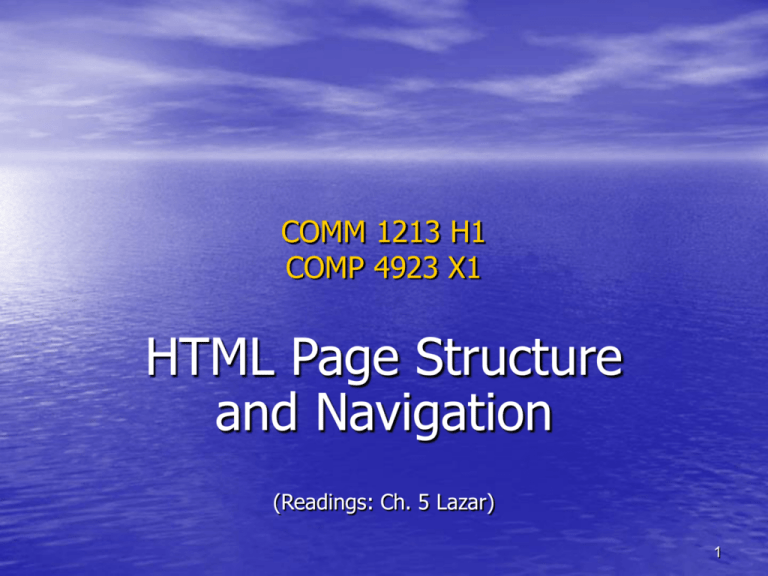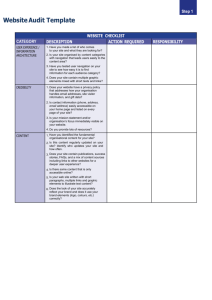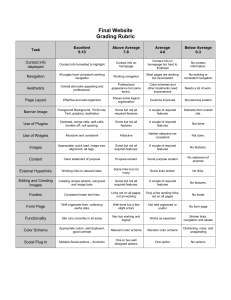COMM 1213 H1 COMP 4923 X1
advertisement

COMM 1213 H1 COMP 4923 X1 HTML Page Structure and Navigation (Readings: Ch. 5 Lazar) 1 Outline • Information Architecture • Site Navigation EG 2 Defintions • Information Architecture – How large information spaces are organized for optimal user interaction – Structure of website • Site navigation – Provides a map through website – Good site navigation = easy to find content – “If the user can’t find it, the information is not there.” 3 Analysis versus Design • Dealt with during design, just after requirements analysis • Requirements analysis What • Design How 4 Important issues during analysis and design: • Purpose and title of webpage • Content to be developed – Consider how it will be developed • How often data will be updated – Who will perform the update • Relationship between content 5 Determine Content Objects • • • • • A well-defined piece of content Smallest granularity of content for the site Static or dynamic (database driven) More than one object can exist per page Example: – catalog entries is an object – a specific item is an instance • Prioritize objects as to their importance – • mandatory, desirable, optional Rarely is all content provided in first release 6 Organize Content Objects • Allocate objects to webpages – use a table • Cognitive models – how users organize information in their minds • Use paper prototypes (cards) and look for – Groupings – Flow – Hierarchy 7 Organize Content Objects • Theoretical Foundations – Menu design – Hierarchical structure is preferred – Series of menus arranged in a tree structure • depth (number of menus levels) • Breadth (number of items per menu) – Short depth, wide breadth preferred .. Why? – Breadth should decreases as depth increases .. Why? 8 Organize Content Objects • Theoretical Foundations – Menu design – No more than 4 or 5 clicks to desired content – Else …. cognitive overload – Humans can deal with 5-9 items / chunks • Consider a food menu structure: – Choice A – list of 500 food items – Choice B – 10 groups of items by country of origin – Choice C – 5 groups based on order of eating 9 Web Navigation • Three types of information for user: – Where they have been • History, back button, visited link colors – Where they are • Title of page = “you are here” sign • Context = site map, bread crumbs, tabs – Where they can go • Descriptive, conveys structure, consistent throughout site 10 Web Navigation • Four most common types: – Topical navigation • Organized by topic - Our course website – Audience-splitting navigation • Directs visitors based on their roles with respect to site - Acadia website – Metaphor navigation • Relate information to objects in user’s life – Organizational navigation • Based on organizational chart • OK for internal, but not external users 11 Location of Navigation • Developer can not be certain of available screen space • Navigation must be easily visible – Top – Left – Combination of top and left 12 Resources • Getting started with HTML from the W3C • W3C's Recommendation for HTML 4.0 is the • • • • authoritative specification for HTML W3 Schools HTML Tutorial HTML Goodies HTML Primer An HTML Code Tutorial Writing HTML a tutorial for creating web pages (a little old but a different perspective) 13 THE END danny.silver@acadiau.ca 14 Architectural of the Internet Acadia Client 1 Application Client 2 Server X TCP/IP Internet Application Intrane t Server Y Server C Server B Server C 15 TCP/IP Protocol Architecture Transmission Control Protocol Internet Protocol 16 TCP/IP Protocol Architecture • Internet Protocol (IP) – like a postcard that contains: – Destination address (131.162.201.7) – Return address – Block of data (content) • Transmission Control Protocol (TCP) – Ensures the post card gets through – Ensures the order of deliver – Handles errors and control flow 17 Client-Server Applications that use the Internet Telnet Window FTP Client eMail Client TCP IP Network Physical Telnet Protocol FTP SMTP/POP Internet Telnet Server FTP Server eMail Server TCP IP Network Physical 18 Major Architectural Components of the Web Client 1 Browser Client 2 HTTP TCP/IP Internet Browser Server A HTTP Server App. Server Database Server URL index.html Server B Server C 19 Images • Various digital image formats can be embedded with in HTML: .gif, .jpg • Example <BODY> <H1>My new baby girl.</H1> <IMG SRC=“NicoleSilver.jpg”> </BODY> • See www.bellsnwhistles.com as source of images and other objects. • Let’s down load one and try it … 20 Hyper Links <HTML><HEAD></HEAD> <BODY> <H1>My Oldest Daughter.</H1> <IMG SRC=“Natalie.jpg”> Natalie goes to <A HREF=“http://www.ems.ednet.ns.ca”>Evangeline Middle School</A> Which is in New Minas. Click <A HREF=“mailto:nsilver@ems.nsed.ca”>Here</A> to send her email. </BODY> </HTML> 21






